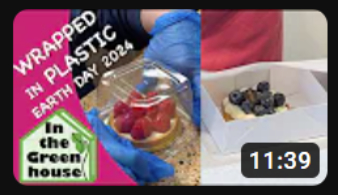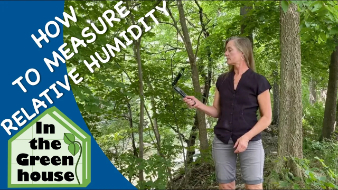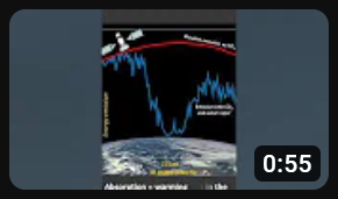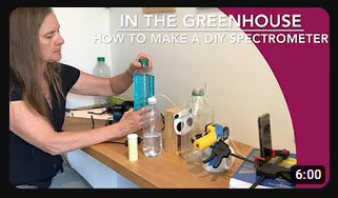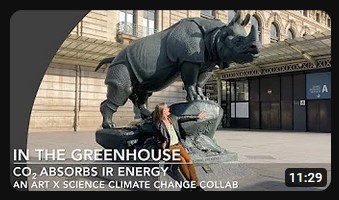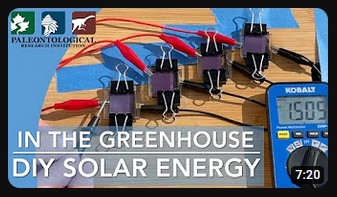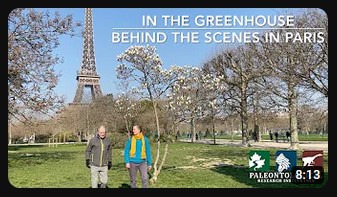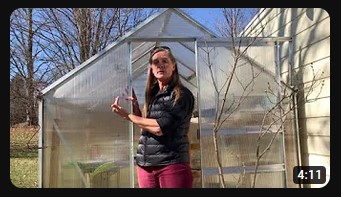These videos feature h
Air temperature and relative humidity determine whether we feel comfortable outdoors, or whether the day is uncomfortably hot--or even dangerously hot. In this video we learn to use a sling psychrometer to measure air temperature and calculate the relative humidity and dewpoint. We'll take a look at how temperatures can change over short distances depending on the kind of site we are examining: how sunny or shady it is, or how much vegetation or pavement is in the surrounding area. Measurements like these give us a better understanding of how resilient our neighborhoods are to climate change.
The interaction of solar energy with the components of our environment —air, earth, and water—drives nearly every natural process that we observe in our surroundings. For example, the absorption of IR energy by greenhouse gases in the atmosphere controls the temperature of the planet. We can also use the absorption of visible light to help us understand the behavior of trace components in water. In this video we learn how to use common materials to make a very basic spectrophotometer. Two experiments using this spectrophotometer are demonstrated in the companion video, "CO2 Absorbs IR Energy: An Art X Science Climate Change Collab."
The spectrum of sunlight extends from wavelengths too short for our eyes to see, through visible light, and into longer wavelengths that are also invisible to us. When sunlight encounters the objects in our environment, its behavior depends on its wavelength. When visible wavelengths are reflected we see different colors. When longer infrared wavelengths are absorbed, objects heat up. Today we do two experiments with two different wavelengths of light--visible and infrared--to better understand some of the basic processes responsible for the temperature of the atmosphere.
Biking Through Women’s History Month (In the Greenhouse #20)
Bicycles are connected both to women's history and to our climate future. In the late 19th century bicycles offered women new freedom and mobility. Today bicycles remain important for women's mobility, and have become an important centerpiece of carbon-free transportation and the redesign of more livable cities. On International Women's Day join Alex in Paris to look at ways that this city is moving forward with active transportation.
Watch CO2 Cross the Street (In the Greenhouse #19)
A short walk around the city with a smartphone and CO2 meter shows the impact of gas-powered vehicles on atmospheric CO2 levels.
Parts per Million: A Little is a LOT (In the Greenhouse #18)
The current concentration of CO2 in Earth’s atmosphere is 415 parts per million. Is that a lot or a little? What is a “part per million,” and what impact does a trace gas – or any trace component in the environment – have on the system as a whole? We’ll explore trace elements with our five senses; sight, sound, small, taste, and touch, and look at the profound impact that trace components have, all around us, every day.
DIY Solar Energy: Photosynthetic Solar Cells (In the Greenhouse #17)
The Sun delivers more energy to Earth in an hour than people use in a year. Plants have used solar energy for millions of years. Here we learn how solar cells work and how to make our own dye-sensitized solar cells using berry juice and a few simple materials. The Cornell Center for Materials Research (CCMR) Lending Library of Experiments provides the necessary equipment. Let’s become smarter humans and learn some lessons from plants!
Behind the Scenes in Paris (In the Greenhouse #16)
To celebrate International Women’s Day and Women’s History Month, take a look behind the scenes at a typical workday for one of PRI’s women science educators. Follow Alex through Paris, where we’ll visit the Natural History Museum to examine gems for clues about the impact of trace components, then on to the Institut de Physique du Globe de Paris and the Curie Pavilion to reflect on the importance of diversity and inclusion in science.
Kitchen Climate Science (In the Greenhouse #15)
It’s Kitchen Climate Science! We’ll use some simple materials commonly found at home to show how anyone, anywhere, can conduct experiments that demonstrate climate change processes and mitigation strategies. For example, measurements of temperature, mass, volume, & time are all routinely made in the process of cooking a meal. These measurements are also fundamental to understanding energy & Earth’s environmental cycles.
Actions to Fight Climate Change (In the Greenhouse #14)
The Greenhouse team takes a road trip, exploring the best ideas from Europe to reduce our carbon footprint and fight climate change. We look at low-carbon energy sources, public transportation, and efficient use of space. Many ideas to reduce fossil fuel emissions are already in practice in Europe, and we can borrow these strategies and adapt them to our needs in the US. Allez!
Behind the Scenes (In the Greenhouse #13)
To celebrate International Women’s Day and Women’s History Month, take a look behind the scenes at a typical workday for one of PRI’s women science educators. Alexandra Moore talks about the process of creating and filming virtual climate change activities.
Respiration: Reuse, Recycle (In the Greenhouse #12)
Natural systems recycle everything! In the global carbon cycle, photosynthesis removes carbon dioxide from the atmosphere and turns it into biomass, while respiration and decay break down biomass and return the CO2 to the atmosphere.
How to Make a CO2 Flux Chamber (In the Greenhouse #11)
In the global carbon cycle photosynthesis and respiration drive an enormous exchange of CO2 between the atmosphere and biosphere. Measuring this exchange is an important part of understanding the carbon cycle. In this video, we learn with Alex how to make the CO2 flux chambers that we use to measure carbon dioxide exchange via photosynthesis and respiration.
Photosynthesis: Plants' Superpower (In the Greenhouse #10)
Through photosynthesis plants combine carbon dioxide and water to create carbohydrates and oxygen. Photosynthesis has a profound and measurable impact on the surrounding environment, not only producing the oxygen that we breathe but also pulling CO2 – a greenhouse gas – out of the atmosphere. In this video, Alex will use a CO2 probe to measure the rate of carbon dioxide flux from the atmosphere to the leaves of plants.
Trees from Thin Air (In the Greenhouse #9)
Trees remove carbon dioxide from the atmosphere – they are quite literally created from thin air! Through photosynthesis, trees combine CO2 and water to create the glucose and other organic molecules that form the mass of a tree. A tree’s mass depends on height and diameter. With simple measurements we learn how to calculate tree biomass, and the mass of carbon dioxide that a tree removes from the atmosphere.
Face the Trace Gas (In the Greenhouse #8)
Atmospheric trace gases like carbon dioxide are a major control on Earth’s climate. Carbon dioxide absorbs infrared energy emitted by the Earth to warm the atmosphere – but – some people wonder if the concentration of a trace gas is high enough to have a significant effect on climate. Join us in this video to calculate the number of CO2 molecules in a one-liter bottle of air and answer that question!
Sunlight Stored in Soil (In the Greenhouse #7)
Energy from the Sun exceeds every other energy source available to Earth: Incoming solar energy diffuses from the surface downward, creating a temperature gradient that we can measure. One place to measure & examine the subsurface temperature gradient is in soil! These data help us to understand the flux of energy through the subsurface, and to explore how natural and human communities can take advantage of this energy source.
Thermal Expansion & Sea Level Rise (In the Greenhouse #6)
A simple experiment has big implications for coastal communities around the globe! Most materials expand when warm and contract when cold. Solar energy stored in the ocean causes seawater to warm and expand, causing sea level rise. In this experiment we measure the thermal expansion of water and calculate its coefficient of thermal expansion. We’ll use this technique to predict sea level rise for different ocean temperature scenarios.
Feel the Heat Capacity (In the Greenhouse #5)
The heat capacity of a substance is the amount of heat required to raise the temperature by one degree. The heat capacity of water determines the behavior of all sorts of phenomena in water bodies as large as the ocean and as small as a water balloon. Join us to explore this critical climate parameter!
IR Energy: Now you see it, now you don't (In the Greenhouse #4)
Different forms of light are characterized by their wavelength. For example, in a rainbow visible light is broken into the color components where each color represents a different wavelength. Longer wavelength IR energy is important for Earth’s climate, as IR interacts with greenhouse gases in Earth’s atmosphere. We’ll use a phone-mounted infrared camera to explore the absorption and/or transmission of different wavelengths of light.
Changes in Global CO2 (In the Greenhouse #3)
In 1896 Swedish Nobel laureate Svante Arrhenius asked, “Is the mean temperature of the ground in any way influenced by the presence of heat-absorbing gases in the atmosphere?” He answered “yes” to this question, and later studied fossil fuel emissions & their impact on global temperature. Since 1958 US scientists have measured the amount of carbon dioxide in the atmosphere from a NOAA observatory. Here we measure the rate of change of atmospheric CO2!
Seeing (Infra)Red (In the Greenhouse #1)
Everything emits energy! Hot objects like the Sun emit visible light, while cool objects like the Earth emit long-wavelength infrared energy. Energy of different wavelengths interacts differently objects in the environment: Gases in the atmosphere can absorb or transmit energy, depending on its wavelength. Absorbed energy warms the atmosphere. Let's take a look at the world in different wavelengths!



